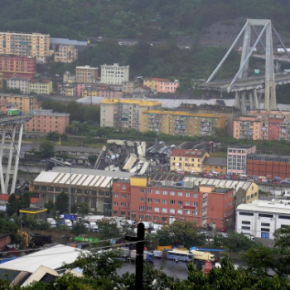
GENOA BRIDGE: Four decades in the making?
 Buildingtalk Online Editor Max Banner takes a look at what could of been behind the collapse of Genoa’s Morandi Bridge, which has so far tragically taken the lives of 43 people.
Buildingtalk Online Editor Max Banner takes a look at what could of been behind the collapse of Genoa’s Morandi Bridge, which has so far tragically taken the lives of 43 people.
A range of possible reasons have been raised for the bridge’s collapse, where cars travelling along it fell a horrifying 45 metres down.
Design flaws have been mentioned as a cause; the tendons on the Morandi bridge are made of reinforced concrete, which contains steel. Steel rusts, meaning it is prone to weakening over time.
Some engineers have long expressed concerns about the concrete-encased stay cables, which are somewhat unusual and used by Morandi in a handful of his bridge designs, as opposed to more common steel cables.
Reinforcement work on the tendons with steel took place in the 1990s.
Morandi himself warned of a corrosion risk four decades ago; a report from 1979 recommended constant maintenance of the structure to remove all traces of rust and fill in exposed patches on the reinforcements.
The report produced 12 years after the bridge opened referred to a “well-known loss of superficial chemical resistance of the concrete” because of sea air and pollution from a nearby steel plant.
Mr Morandi, who died in 1989, had a strong belief the reinforced concrete bridge design was okay but referred to the “aggressivity” of the corrosion that was not seen in similar structures in different environments.
=====================
General wear and tear has been raised a possibility; was completed in 1967, and normally a bridge is designed to last for at least 100 years.
In December 2012, a public hearing into how to expand the local transport infrastructure saw Genoa’s city council discussed the state of the Morandi bridge, with an industry official warning the bridge could collapse ‘in 10 years’.
=====================
Heavy traffic on the bridge may have also contributed to its weakening, over which approximately 25 million vehicles pass per year – it carries a major artery, the A10, that serves the Italian Riviera and links northern Italy to France.
A considerable drop in investment in the country’s infrastructure, which falls behind other economies in western Europe, could also be scrutinised.
It is also important to note the collapse occurred amidst a storm and extremely strong winds.
Also, the motorway operator said work to improve the bridge’s foundation was being undergone at the time of the collapse, whereby it was being constantly monitored.
=====================
The government of Italy has ordered an investigation, but experts warn it is too soon to look at only one cause too severely and with many venting their frustrations at the those in positions of power themselves, this is likely to be a tragedy that will take some time to get answers to.
(Image courtesy of Reuters)
Latest news

26th July 2024
Enfield Speciality Doors completes world-class project for Atlas Copco HQ
A rundown office and warehouse building completely transformed into a modern headquarters for Atlas Copco has been fitted with more than 120 internal fire doors from Enfield Speciality Doors.
Posted in Access Control & Door Entry Systems, Articles, Building Industry News, Building Products & Structures, Building Systems, Case Studies, Doors, Interior Design & Construction, Interiors, Posts, Restoration & Refurbishment, Retrofit & Renovation, Security and Fire Protection, Sustainability & Energy Efficiency, Timber Buildings and Timber Products, Wooden products
26th July 2024
Abloy UK launches new white paper
Abloy UK, a leading provider of security and access control solutions, has launched a new white paper.
Posted in Access Control & Door Entry Systems, Architectural Ironmongery, Articles, Building Industry News, Building Products & Structures, Building Services, Doors, Facility Management & Building Services, Health & Safety, Information Technology, Innovations & New Products, Publications, Research & Materials Testing, Security and Fire Protection
26th July 2024
MCRMA Member Profile: David Roy, Director of Roofconsult
David Roy of MCRMA member company Roofconsult has more than 50 years’ experience to draw upon working in the building envelope sector and a unique perspective on how it has changed in that time.
Posted in Articles, BIM, Infrastructure & CAD Software, Building Associations & Institutes, Building Industry News, Building Products & Structures, Building Services, Building Systems, Cladding, Information Technology, Restoration & Refurbishment, Retrofit & Renovation, Roofs, Walls
26th July 2024
Strand: Enhancing Door Functionality and Safety
Craig Fox, Sales Director for Strand Hardware, outlines how door industry professionals might apply door limiting stays…
Posted in Architectural Ironmongery, Articles, Building Industry News, Building Products & Structures, Building Services, Doors, Facility Management & Building Services, Health & Safety, Restoration & Refurbishment, Retrofit & Renovation
 Sign up:
Sign up: